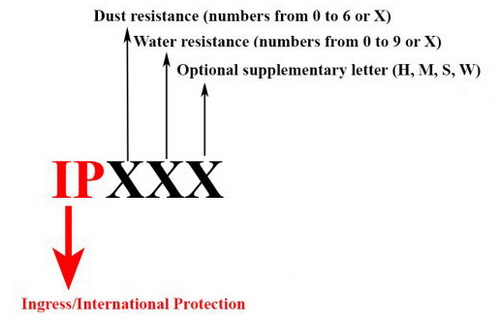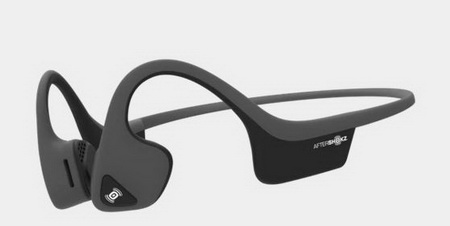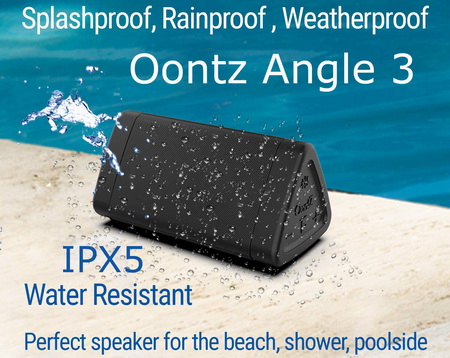AudioReputation is reader-supported. When you buy through links on our site, we may earn an affiliate commission Learn More
Don’t you hate it when your earbuds stop working after a few sweaty workouts? Or when your new Bluetooth speaker dies because of a few splashes of water from the pool? There’s a simple and fairly affordable solution for your problems – make sure that your next Bluetooth speaker or Bluetooth earbuds are waterproof or at least water-resistant. But is there a way to tell how resistant a certain device is? Well, of course, there is – just check if the device is IPX-certified and what kind of IPX rating it has.
Our article is here to give you a detailed explanation of the meaning and significance of the IPX5 water-resistant rating but, to put things in context, we also have to explain the meaning of other IPX ratings and make some comparisons between different levels of protection. So, everything you need to know about IPX5 and other water-resistant/waterproof ratings is right below.
Table of Contents
- What’s So Important About IP/IPX Ratings?
- What Different IP/IPX Ratings Really Mean?
- Why Do We Need to Know if a Device is Waterproof/Water-Resistant?
- What Can I Do with my IPX5-Certified Phone/Speaker/earbuds?
- Misleading IPX Terminology
- FAQs
- Q: What does IPX5 water-resistant mean?
- Q: Can you shower with an IPX5-certified device?
- Q: What IP rating is waterproof?
- Q: What is the best waterproof rating?
- Q: Is IPX5 good for rain?
- Q: Can you shower with water-resistant earbuds?
- Q: How do you know if earbuds are waterproof?
- Q: Does water-resistant mean sweat-resistant?
What’s So Important About IP/IPX Ratings?
IP stands for Ingress Protection (or International Protection). It is an international standard, strictly defined by the IEC (International Electrotechnical Commission). IP code describes the level of protection against ingress of solid particles and liquids. Here’s the general form of an IP code (IP rating).

As you can see from the image, there can be up to three digits/letters after that IP mark. In most cases, there will be only two numbers or a letter X and a number. This applies to all consumer electronics.
Each X in that form has its meaning. The first one describes the protection against the ingress of dust particles. It can be any number between 0 and 6 (0 – not dustproof at all, 6- fully dustproof) or it can be an X (if the product is not tested for dust ingress).
The second X describes the protection against the ingress of water. It can be any number from 0 to 8 (0 – not waterproof nor water-resistant, 8 – fully waterproof and submersible in water). This value can also be 6K (resistant to water jets with increased pressure) or 9K (resistant to high-temperature water jets). Or it can also be an X (if the device is not tested).
The third one is optional and you will never see it in consumer electronics.
So, what’s so important about these IP/IPX rating? Well, they tell us how dust-resistant and/or water-resistant a certain device is, and that’s important for both – manufacturers and us, buyers.
For the manufacturers, this is a big selling point and helps them with advertising. It’s an important feature that also allows them to raise the price a little bit.
For the buyers, the existence of an IPX rating is also an important feature, especially when looking for a water-resistant or waterproof device. They don’t have to take the manufacturer’s word for it – they can just check if there’s an IPX rating and, assuming that they know what each IPX rating means, they will know what to expect. It’s much easier when you know that a device you want to buy has passed some standardized tests.
What Different IP/IPX Ratings Really Mean?
For each IPX rating, there’s a standardized test defined by the international standard issued by the IEC (IEC 60529). This standard defines both – the conditions and the equipment used for the certification. If a device passes the test, it gets a certificate. Have in mind that if a device is rated as IPX7 or IPX8 (waterproof), that doesn’t mean it’s dustproof. It could be, but it doesn’t have to be. There are separate tests for each waterproof/water-resistant/dustproof rating. If a device is fully dustproof and waterproof, you will see something like IP67 or IP68 and not IPX7/IPX8.
Ratings IPX1 and IPX2 guarantee only mild protection against water ingress. To to get one of these two ratings, a device has to pass the water dripping test. In the case of IPX1, the water drops fall vertically simulating a very light rain (1mm/min) for a very short time (10 minutes). In the case of IPX2, the device has to be tilted (at 15° angle), and the water drops simulate a moderate rain (3mm/min). The test is repeated 4 times.
IPX1/IPX2 Certification
Like in the case of IPX1 and IPX2, the certification for IPX3 and IPX4 ratings is done with the same equipment but under different conditions. An IEC-approved nozzle or an oscillating tube is used for the certification. In the case of IPX3, you have a nozzle with a counterbalanced shield and the device is sprayed for 5 minutes at different angles (up to 60 degrees from the vertical axis), and the amount of sprayed water equals 50 liters. In the case of IPX4, the counterbalanced shield is removed. Most of the conditions are the same but the device is sprayed at all angles. IPX4 rating is the first one that offers some serious protection. Devices with an IPX4 rating are often considered ‘splash-proof’.
Certification procedures for IPX5 and IPX6 are also very similar. The same equipment is used. The device has to withstand strong water jets and the difference between IPX5 rating and IPX6 rating is only in the jet pressure. In the case of IPX5, it’s 30 kPa, and in the case of IPX6, it’s 100 kPa. The distance between the nozzle and the device is 3 meters, and the test duration is 1 min. If a device has IPX5 or IPX6 rating, it’s usually considered water-resistant
IPX5/IPX6 Certification Process
Like in all the previous cases, certification procedures for IPX7 and IPX8 ratings are very similar and the same equipment is used for both tests. In both cases, the device has to be fully submerged in water. The difference is in the conditions – water depth and duration. In the case of IPX7, the test lasts 30 minutes and the water depth is 1m. In the case of IPX8, the conditions are defined in cooperation with the manufacturer (they are not strictly defined by the IEC) but they have to be more serious (greater water depth and longer duration). Devices with IPX7 and IPX8 ratings are considered fully waterproof. IPX8 devices are sometimes even hermetically sealed. They can even be used underwater.
IPX7/IPX8 Immersion Tank
In addition to these 8 most common water-resistant and waterproof ratings, there’s also an IPX9K rating. Consumer electronics are practically never tested for the 9K rating. A device with an IPX9K rating can withstand very strong (8-10MPa) high-temperature (176 °F/80 °C) water jets. The test is repeated 4 times and each test lasts 30 seconds.
IPX9K Certification Procedure
Why Do We Need to Know if a Device is Waterproof/Water-Resistant?
If you are absolutely certain that your device, whether it’s a phone, or a Bluetooth speaker, or Bluetooth earbuds/headphones, is never going to get in contact with water, sweat, or any other liquid, then no. If you’re that careful, you don’t have to care about waterproofness at all.
The chances are you are not that careful. Most of us are not. That’s why knowing an IPX rating can help you choose the right device for your needs. Depending on the intended use, you will need a device that is more or less resistant to water ingress. If you’re going to use your earbuds/headphones for workouts or running, then you should probably go for IPX4 or higher rating. If you’re going to use the device around the pool or want to bring it to the beach IPX5 or higher rating is recommended but it’s probably smarter to go for an IPX7 or IPX8 device. Just in case…
What Can I Do with my IPX5-Certified Phone/Speaker/earbuds?
IPX5 rating is ideal for running. Many of today’s sports earbuds/headphones are IPX5-certified.

AfterShokz Air IP55-certified bone conduction headphones (source – AfterShokz)
Spilling a glass of water over an IPX5-certified device shouldn’t cause any damage.
As the image from the introduction implies, an IPX5 water-resistant speaker is a good choice for beach or poolside. However, IPX5 rating doesn’t mean that a device will stay functional if it falls into the pool (if it gets submerged in water). For that, you need either IPX7 or IPX8 speaker.
Some would even say that IPX5 is good for shower use and most IPX5 speakers and earbuds can withstand that but we still recommend at least IPX6-certified devices for that purpose. There’re two reasons for that.
First, the water jets used for IPX5 certification are not as strong as the water jets of a good shower. However, the difference in pressure between an IPX5 water jet and shower is not huge so that isn’t the biggest problem.
The second problem is the water temperature. IPX5 certification is done with cold tap water (55-65 °F or 13-18 °C), while the temperature of water you use in the shower is hotter (optimal temperature is 112 °F or 44 °C). When the water is hot, there is also vapor and, as you know, vapor is a gas and it can enter the areas that water cannot. When the temperature goes down, the vapor is condensed and turned into the water again. But now, the water is inside your speaker and it could damage internal electronic parts or cause corrosion of metal parts like wires. If a speaker is IPX5 water-resistant and moisture protected, then you can probably use it as a shower speaker. Also, some sort of protection from dust ingress (like IP55) is desirable.
Misleading IPX Terminology
There’s a multitude of terms used to describe the waterproofness of a device – splash-proof, weatherproof, hydrophobic, water-resistant, sweat-resistant, rainproof, water-repellant, watertight, showerproof, sealed (hermetically sealed), coated for protection against water ingress, etc.
None of these terms has any meaning unless it’s supported by an actual IP or IPX rating. If a device is not IP/IPX-certified, you can only trust the manufacturers’ claims. But there’s no proof that a device is what they say it is.
Also, you should pay attention to the way the IP/IPX rating is written. The only correct way is without a hyphen or an empty space. So, IPX5 is CORRECT but IPX 5 or IPX-5 is NOT CORRECT.
FAQs
Q: What does IPX5 water-resistant mean?
A: IPX5 water-resistant rating means that a device will keep working after being sprayed by a nozzle defined by the IEC 60529 standard. When sprayed with a 30 kPa water jet for at least one minute from a 3m distance, an IPX5-certified device will not be damaged in any way.
Q: Can you shower with an IPX5-certified device?
A: We have already discussed this question in our article so if you want a full explanation, read the article. The short answer would be yes. In most cases, at least.
However, the conditions in the shower are not exactly the same as the conditions for IPX5 certification. There’s a mild difference in water pressure (which should not be a huge problem) and a bit more important difference in water temperature (the shower water is hotter).
Q: What IP rating is waterproof?
A: If a device (speaker/earbuds/phone) is IPX7 or IPX8-certified, it is considered fully waterproof. What that means is that a device can survive immersion in water (up to 1m depth for IPX7 or deeper than 1m for IPX8).
Q: What is the best waterproof rating?
A: It all depends on what you actually need. If you want to listen music while swimming, IPX8 would be ideal. IP68 is even better.
Q: Is IPX5 good for rain?
A: IPX5 water-resistant devices are perfectly capable of withstanding light or moderate rain.
Q: Can you shower with water-resistant earbuds?
A: Technically, yes. You can shower with water-resistant earbuds, and they will stay functional after the shower. However, IPX5 and IPX6 certification tests are performed with cold water while the shower water is hot. As you know, hot water creates steam, and when the temperature decreases, the steam turns into water. The steam can reach some internal parts that water cannot, and when it’s condensed, it could cause corrosion of metal parts.
And by the way, having a shower with your earbuds on your head is highly impractical.
Q: How do you know if earbuds are waterproof?
A: The only real proof of waterproofness is IP or IPX rating. IPX7 or IPX8, to be more specific. If there’s no IPX rating, then you can only take the manufacturer’s word for it, and that’s not the best idea.
Q: Does water-resistant mean sweat-resistant?
A: Technically, it does not. A water-resistant device is either IPX5 or IPX6-certified, and the certification test is performed with water. That’s the only liquid used for certification. Sweat is almost entirely water, but it also contains ammonia, salts, urea, and sugar.
In practice, however, almost every water-resistant device will survive heavy sweating. Even IPX4 devices are supposed to withstand heavy sweating.

Hello, my name is James Longman.
I’m a writer and editor at AudioReputation. I disassembled my first portable AM/FM radio when I was only 8. At the age of 11, I burned the circuit board on my old boombox cassette player. I’m not going to explain how but it was reckless and stupid.
Since then, I have become much more careful around radios, boomboxes, and other audio devices (at least, I like to think so) but I have never lost the passion for audio equipment. Throughout 20 years of my professional career, I’ve been working for various audio equipment manufacturers and even started building speakers on my own in my little workshop.
I love the work we do here at AudioReputation. Testing, comparing, and evaluating all kinds of audio devices (speakers, soundbars, headphones, home theater systems, etc.) is something I truly enjoy. I try to be unbiased and give you my honest opinion on every piece of equipment I test. Still, you should take my reviews with a pinch of salt and always be just a little bit skeptical. The fact that I liked some speaker or soundbar doesn’t mean that you are going to love it. If you have the opportunity, you should test it/hear it before buying it.


